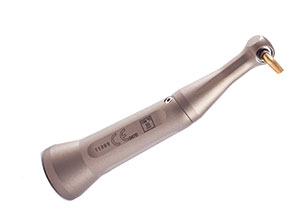The use of disposable electrode tips in radiosurgery—one of several types of electrodes designed for radiosurgery instruments—is among the many changes that have occurred in dentistry in recent years.1 This is largely due to the increased use of bonded restorations and changes in infection control guidelines. The use of bonded restorations is on the rise because enhanced bonding materials allow posterior placement of composites rather than amalgam restorations. In addition, laboratories are using all-porcelain restorations, which can be bonded into position. Onlays, veneers, Procera (Nobel Biocare) crowns, and FibreKor (Pentron Laboratory Technologies) restorations require a clean, dry, blood-free area to ensure an adequate bond to tooth structure.
 |
 |
| Figure 1. A disposable, u-shaped electrode is used to perform a gingivectomy. | Figure 2. A disposable, pencil-shaped electrode is used to establish coagulation after tissue removal. |
Radiosurgery, a technique that uses radio waves instead of a scalpel to achieve a smooth incision, is a modality for removing gingival tissue with increased hemostasis2 (Figures 1 and 2). Research demonstrates its effectiveness in safely removing tissue without consequence to the surrounding gingival or osseous tissue. Radiosurgery is now commonly used in implant placement and exposure as well. Oral and periodontal surgeons, seeking ways to make more precise incisions at a fraction of the cost of a laser, are also using radiosurgery. The growing popularity of laser technology—as well as earlier electrosurgery techniques—is contributing to this trend.
INFECTION CONTROL IN RADIOSURGERY
Dental patients and dental healthcare professionals can be exposed to pathogenic microorganisms transmitted through direct contact with blood, oral fluids, or other materials; indirect contact with contaminated objects (eg, instruments, equipment, environmental materials); and inhalation of airborne microorganisms, among other methods.3
Updates in infection control guidelines in dentistry, issued by the Centers for Disease Control and Prevention in 2003, are changing sterilization processes for electrode tips and handpieces in radiosurgery.3 Early literature on electrosurgery indicates that the tips were self-sterilizing: bacteria were destroyed when power was activated. However, the protective covering on the electrode tip and the handpiece were not affected. Practitioners would later immerse electrode tips in germicide solutions to attempt to cold-sterilize them. The development of autoclavable handpieces (those that can be sterilized through steam pressure) and electrode tips was a major improvement in infection control, and today they are used in many radiosurgical and electrosurgical instruments.
DISPOSABLE ELECTRODE TIPS
 |
| Figure 3. Disposable electrodes are available in boxes of assorted shapes. |
The single-use, disposable electrode tip, originally developed for application in the medical field, is the latest advance in radiosurgery, and many regard it as the safest cutting tip available (Figure 3). It is based on the same principle as disposable scal-pel blades. Single-use in de-sign, the tips will not tolerate heat sterilization and should not be cold-sterilized, since their sterility cannot be assured.4 One advantage of a single-use, disposable electrode tip is that there is always a clean, unbent electrode to work with. Gone are the days of broken loop electrodes and bent, straight-wire tips. Disposables also eliminate the chance of needlesticks that may occur when cleaning straight-wire electrode tips.
 |
| Figure 4. A heavily autoclaved, 135 ball-shaped electrode compared with a new, single-use disposable electrode of the same shape. |
Testing agencies recommend that all radiosurgical handpieces and electrode tips be replaced after every 100 autoclave cycles to help ensure efficient performance and safety. Electrode tips that are darkened or corroded from excessive sterilization should be discarded. The single-use, disposable electrode tip eliminates this problem and keeps the instrument operating efficiently (Figure 4).
The cost of disposable electrode tips (Ellman Inter-national), which can be in-corporated into the cost of the surgical procedure, is about $4 each. The per-unit cost is even less if they are purchased in bulk. In time, disposable electrodes likely will be offered by all manufacturers of radiosurgical equipment.
References
1. Sherman JA. Oral Radiosurgery: An Illustrated Clinical Guide. London: Martin Dunitz; 1997.
2. Sherman JA. Radiosurgery: an adjunct to the bonded restoration. Dent Today. 1999;18(8):92-93.
3. Kohn WG, Collins AS, Cleveland JL, et al; Centers for Disease Control and Prevention. Guidelines for infection control in dental health-care settings – 2003. MMWR Recomm Rep. 2003;52(RR-17):1-61.
4. DePaola LG. Infection control and dental practice: frequently asked questions. Compendium Continuing Education in Dentistry. 2004;25(suppl)(1):38-42.
Dr. Sherman is a leading authority in the field of radiosurgery. He is the author of 2 textbooks on the subject and has published numerous articles in international and national dental journals. He has also developed 2 technique videos. A diplomate of the American Board of Oral Electrosurgery and fellow of the American College of Dentists and the International College of Dentists, he has lectured at numerous dental schools and meetings throughout the world. He maintains a private general dental practice in Oakdale, NY, and can be reached at (631) 567-2100 or esurg@aol.com.










